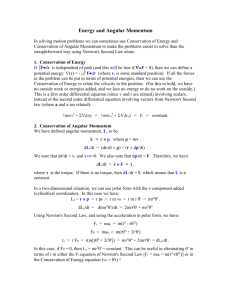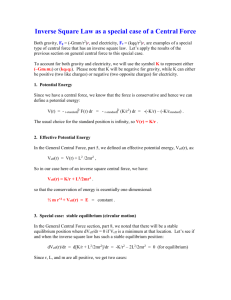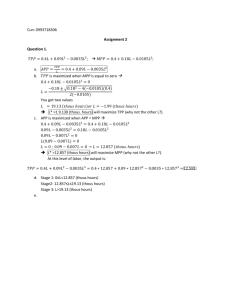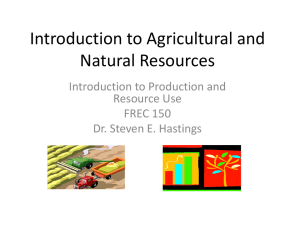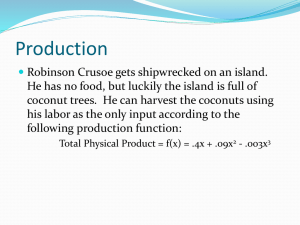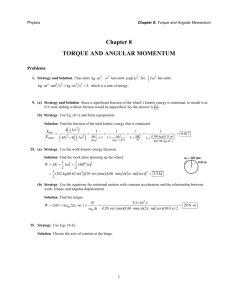CentralForce
advertisement
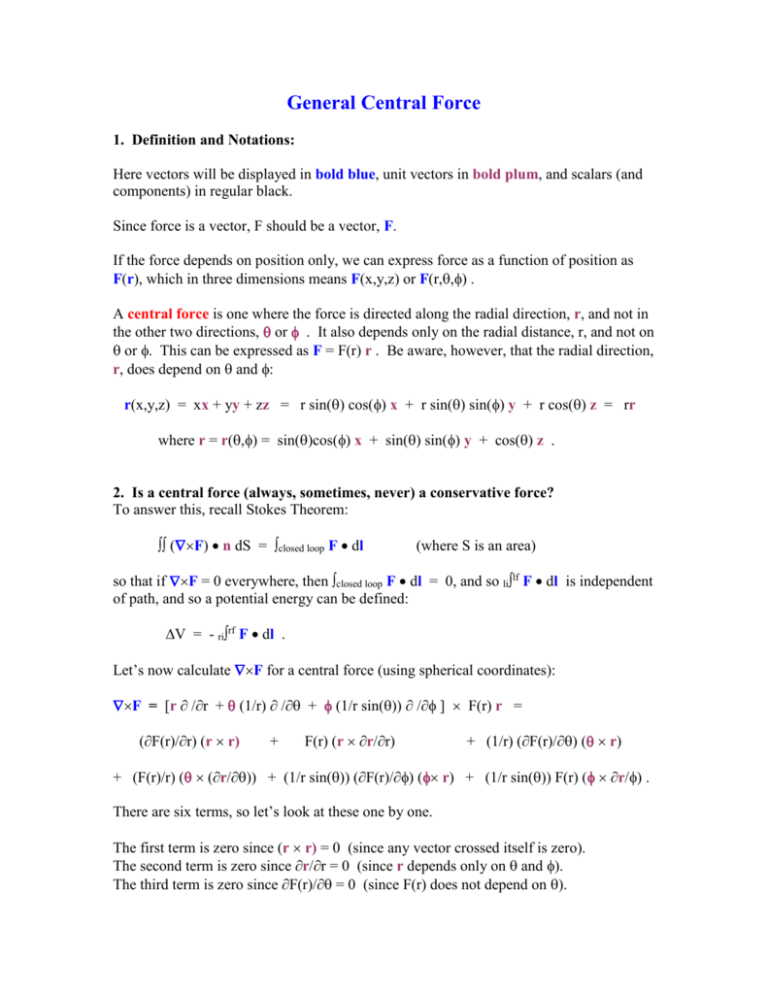
General Central Force
1. Definition and Notations:
Here vectors will be displayed in bold blue, unit vectors in bold plum, and scalars (and
components) in regular black.
Since force is a vector, F should be a vector, F.
If the force depends on position only, we can express force as a function of position as
F(r), which in three dimensions means F(x,y,z) or F(r,,) .
A central force is one where the force is directed along the radial direction, r, and not in
the other two directions, or . It also depends only on the radial distance, r, and not on
or . This can be expressed as F = F(r) r . Be aware, however, that the radial direction,
r, does depend on and :
r(x,y,z) = xx + yy + zz = r sin() cos() x + r sin() sin() y + r cos() z = rr
where r = r(,) = sin()cos() x + sin() sin() y + cos() z .
2. Is a central force (always, sometimes, never) a conservative force?
To answer this, recall Stokes Theorem:
(F) n dS = closed loop F dl
(where S is an area)
so that if F = 0 everywhere, then closed loop F dl = 0, and so lilf F dl is independent
of path, and so a potential energy can be defined:
V = - rirf F dl .
Let’s now calculate F for a central force (using spherical coordinates):
F = [r /r + (1/r) / + (1/r sin()) / ] F(r) r =
(F(r)/r) (r r)
+
F(r) (r r/r)
+ (1/r) (F(r)/) ( r)
+ (F(r)/r) ( (r/)) + (1/r sin()) (F(r)/) ( r) + (1/r sin()) F(r) ( r/) .
There are six terms, so let’s look at these one by one.
The first term is zero since (r r) = 0 (since any vector crossed itself is zero).
The second term is zero since r/r = 0 (since r depends only on and ).
The third term is zero since F(r)/ = 0 (since F(r) does not depend on ).
The fourth term is zero since r/ = , and ( ) = 0.
The fifth term is zero since F(r)/ = 0 (since F(r) does not depend on ).
The sixth term is zero since r/ = sin() , and ( ) = 0.
Therefore, F = 0 for F = F(r)r, so a central force is always a conservative force!
We can then define a potential energy function:
V(r) = - r-standardr F(r) dr .
3. Torque and Angular Momentum for a Central Force
Starting with the definition of torque as = r F, for a central force, F = F(r)r,
we have (recalling that r = rr): = r F(r)r = r F(r) r r = 0. Central forces can
create no torque.
Now we recall the relation between torque and angular momentum (L): = L/t .
Since torque under a central force is zero, the angular momentum must remain constant.
Let’s now get an expression for angular momentum in polar coordinates. We can use
2-D polar coordinates (instead of 3-D) since a central force has no component of either
motion or force perpendicular to the (r v) plane. By definition, L = r p = r mv .
In polar form, v = dr/dt = d(rr)/dt = (dr/dt)r + r(dr/dt) = r’r + r’
(where r’ = dr/dt, and ’ = d/dt) .
Therefore,
L = rr m(r’r + r’) = mrr’(r r) + mr2’(r ) = 0 + mr2’ z = constant.
Note that if we know the initial conditions, ro and ’o, we can calculate the value of L.
If we just consider the magnitude, since the direction will not change,
L = mr2’ = constant.
This equation provides a relation between the radius, r and the angular speed, ’ (which
we sometimes have called ). We can write this as:
’ = L/mr2 .
4. Newton’s Second Law for a Central Force
F = ma is a vector equation, which means it is one equation for each dimension. For a
central force, F = F(r) r, in polar coordinates we have Fr = F(r) , and F = 0 . The
acceleration expressed in polar form is: ar = r’’ – r’2 (where r’’ = d2r/dt2 is the usual
linear acceleration in the radial direction, and r’2 = w2r is the circular acceleration); and
a = r’’ + 2r’’ (where r’’ is r(d2/dt2), the acceleration in the circular direction, and
2r’’ is that strange Coriolis acceleration). Therefore, in component form, Newton’s
Law becomes:
r component: F(r) = m(r’’ – r’2) , or F(r) + mr’2 = mr’’
[where the term mr’2 = m2r can be considered the “centrifugal” force]
component:
F = 0,
so
0
= m(r’’ + 2r’’) .
If we use the angular momentum equation, ’ = L/mr2 in the radial equation, we get:
F(r) + mr(L/mr2)2 = mr’’, or F(r) + L2/mr3 = mr’’
which is an expression that is equivalent to a one-dimensional problem since there is no
mention of ..
5. Conservation of Energy
Since a central force is a conservative force, we can define a potential energy. If there
are no other forces, then energy is conserved and we can write this in an equation:
KE + PE = E = constant
v = vrr + v , and v2 = vr2 + v2 = (r’)2 + (r’)2
so we get:
½ m r’2 + ½ m r2 ’2 + V(r) = E .
If we use the angular momentum expression, ’ = L/mr2, this becomes:
½ m r’2 + ½ m r2 (L/mr2)2 + V(r) = E = ½ m r’2 + ½ L2 /mr2 + V(r) .
If we treat the term ½ L2 /mr2 as an additional potential energy (since it only depends on
r), we can define an effective potential energy: Veff(r) = V(r) + L2 /2mr2 . We now
have an equation that is essentially one-dimensional:
½ m r’2 + Veff(r) = E = constant .
6. Straightforward solutions
a) Use the Conservation of Energy (1-D) equation with the equivalent potential energy,
and use the technique we used earlier in the course to first get r(t) and then to get (t):
½ mr’2 + Veff(r) = E
(where Veff(r) = V(r) + L2 /2mr2 )
dr/dt = r’ = [2(E-Veff(r))/m ]½
t
0
dt =
r
ro
{1 / [2(E-Veff(r))/m ]½ } dr
Assuming we can actually do the integration over r, we get an expression for t(r).
Then we must find the inverse to get r(t). This is sometimes very difficult.
If we can get r(t), we can then use the angular momentum expression: L = mr2’ to get
an expression for ’:
’ = L/mr(t)2 .
We can then use ’ = d/dt to get:
0
d =
t
0
’ dt =
t
0
[L/mr(t)2] dt .
If we can do the integration, we then have an expression for (t) and the problem is
solved.
b) Use Newton’s Second Law to try to get r() [instead of r(t) and (t)]. While this will
lose some information (time information), it has the advantage of giving us the orbits
directly. We start with the equivalent 1-D relation (see part 4 above):
F(r) + L2/mr3 = mr’’ .
Since we want r(), we note that (recalling that ’ = L/mr2) :
r’ = dr/dt = (dr/d)*(d/dt) = (dr/d)*’ = (dr/d)*(L/mr2) .
r’’ = d(r’)/dt = (dr’/d)*(d/dt) = d[(dr/d)*(L/mr2)]/d * ’
= (d2r/d2)*(L/mr2)*’ + (dr/d)*(L/m)*(d[1/r2]/d)*’
note: d[1/r2]/d = (d[1/r2]/dr)*(dr/d) = (-2/r3)*(dr/d)
r’’ = (d2r/d2)*(L/mr2)*’ + (dr/d)*(L/m)* (-2/r3)*(dr/d)*’
(and again using ’ = L/mr2 )
r’’ = (d2r/d2)*(L2/m2r4) - (2L2/m2r5)*(dr/d)2 .
Using this, we can now write Newton’s 2nd Law (r component equation) as:
F(r) + L2/mr3
= (d2r/d2)*(L2/mr4) - (2L2/mr5)*(dr/d)2 .
This doesn’t look all that easy to solve.
7. Tricky way to solve for r()
Sometimes things look nicer in one form than in another. We will try a trick that
involves substitution: let’s define u = 1/r (or r = 1/u).
L = mr2’ = m’/u2,
or
’ = Lu2/m
r’ = dr/dt = (dr/du)*(du/dt) = (dr/du)*(du/d)*(d/dt) = (d(1/u)/du)*(du/d)*’
= (-1/u2)*(du/d)*’ = (-1/u2)*(du/d)*(Lu2/m) = (-L/m)*(du/d).
r’’ = dr’/dt = (dr’/d)((d/dt) = d[(-L/m)*(du/d)]/d * ’
= (-L/m)*(d2u/d2)*(Lu2/m) = (-L2u2/m2)*d2u/d2
Newton’s Second Law (r component equation)
F(r) + L2/mr3 = mr’’
thus becomes:
F(1/u) + L2u3/m = m*(-L2u2/m2)*d2u/d2 , or
(-m/L2u2)*F(1/u) + (-m/L2u2)*(L2u3/m) = d2u/d2 , or
(-m/L2u2)*F(1/u) + -u
= d2u/d2 .
This looks better than the straightforward way above because the r’’ term gives only one
term instead of two terms when we use this particular substitution. This is because the r’
term does not have any u’s in it – a result of our particular choice for substitution.
8. Special Cases
a) One of Kepler’s Laws of planetary motion
Consider an area of the orbit, dS, that is swept out in a small unit of time, dt:
vdt = r’dt
dS
r
The distance covered by vrdt does not cover an area since it’s direction is parallel to r.
The distance covered by vdt does cover an area of a triangle, so dS = ½r*(r’dt) =
½r2’dt. We now use the relation ’ = L/mr2 to get
dS/dt = ½r2(L/mr2) = L/2m = constant.
This is one of Kepler’s laws for planetary motion: a planet sweeps out equal areas in
equal time intervals. Note that this law applies for ANY central force, not just for the
inverse square gravity force.
We can go even further to get:
dS = (L/2m) dt,
or if we integrate over the complete orbit, we get:
S = (L/2m)T
where T is the period of orbit and S is the area of the orbit..
b) Oscillations near equilibrium
If we use the effective potential (see part 5 above):
Veff(r) = V(r) + L2 /2mr2 ,
we now have an equation that is essentially one-dimensional:
½ m r’2 + Veff(r) = E = constant .
If there is a stable equilibrium position (where dVeff/dr = 0, and Veff is a minimum at this
value of r), then we should be able to get circular motion (where r’=0), since the central
force (if it is attractive) can cause the centripetal acceleration. If we provide a little more
energy than necessary for this stable circular motion, we should get oscillations (in the
value of r) about this stable value of r. (See the first part of the course, under Potential
Wells and Oscillations.) The frequency, , in which r oscillates is given by
osc = [k/m]½ , where k = (d2Veff/dr2)r-equilibrium .
Note: the above angular frequency, , is the frequency that r oscillates around the
circular radius, requilibrium. This osc is not the same thing as ’, which is the angular
frequency that the motion has going around the center of the force.
Example: Given a spherically symmetric harmonic oscillator with V = ½ kr2.
(To visualize this, picture a mass on a spring in outer space – no gravity – where the
spring is free to rotate about one end with the mass on the other end.)
a) What is the frequency for circular motion at a radius of ro ?
b) What is the frequency for small oscillations of r about ro ?
c) Describe the orbits for small oscillations of r about ro .
a-1) For circular motion, r = constant so r’ = 0 and r’’ = 0, so the r component equation
of Newton’s 2nd Law: F(r) = m(r’’ – r’2) becomes, with ’ = c :
Fr = mar = m(-c2r). Fr = -dV/dr = -kr . Putting these two expressions together gives:
- kr = -mc2r , or c = [k/m]1/2 .
a-2) For stable orbit, want dVeff /dr = 0 where Veff = ½ kr2 + L2/2mr2 so we get the
condition: kr – L2/mr3 = 0, or ro4 = L2/mk . We have L = mvr = m(cr)r = mcr2 ,
or
c =
L/mro2 = L/m(L/[mk]1/2 = [k/m]1/2 .
Note that c does not depend on the radius! As the radius gets bigger, c stays the same
and the v = c*r gets bigger.
b) For small oscillations about the bottom of the potential well, osc = [k’/m]1/2
where k’ = (d2Veff/dr2)ro = (d2[½ kr2 + L2/2mr2] /dr2)ro = k + 3L2 /mro4 , so
osc = [k’/m]1/2 = [ {k + 3L2 /mro4}/m ]1/2 = [(k/m) + 3L2/m2ro4]1/2 = [c2 + 3c2]1/2 ,
or
osc = 2c .
c) For one cycle around the circle, the radius grows bigger and gets smaller and grows
bigger again twice. The origin is still right in the center.
x
x
Homework Problem #21: For an inverse square law force with effective potential
energy, Veff(r) = K/r + L2/2mr2 ,
a) find the frequency of small radial oscillations about the equilibrium (circular)
radius of orbit;
b) show that this frequency of small radial oscillations is equal to the frequency
of the circular orbit. (This makes the circular orbit into an elliptical one).
